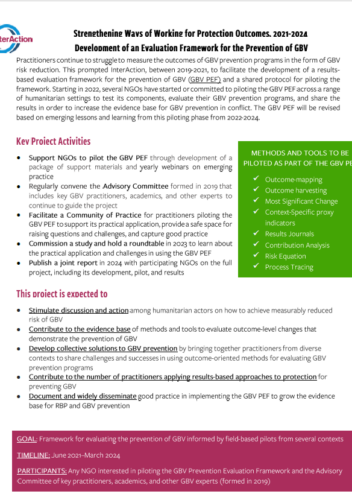Featured Resource
 Protection for People: What Do We Mean? Guidance for Senior Leadership
Protection for People: What Do We Mean? Guidance for Senior Leadership

InterAction has published and collected resources including tools, reports, project evaluations, blogposts, and others from Members and partners that promote results-based approaches to protection since 2012; all of which can be found in this resource library. To explore practical case examples of RBP in practice, visit the case example page. Background photo By: Simon Moricz Sabjan is licensed under the CC BY-NC 4.0 license.
Save the Children has released a report reviewing ten of its programs to assess the effects that CVA has on CP outcomes, identify evidence gaps, and document best programmatic practices for learning.

In January 2022, the Alliance for Child Protection in Humanitarian Action (ACPHA) and USAID published a Primary Prevention Framework for Child Protection in Humanitarian Action. The guiding principles of the framework echo many of the principles of Results-Based Protection, including the focus on prevention as well as the importance of context-specific protection risk analysis.

Oxfam alongside its partner organizations has developed a resource pack on community-based protection (CBP) titled, ‘From Participation to Leadership.’ The goal of the resource is to provide guidance on the implementation of CBP across a full program cycle and to share experiences directly from protection organizations and members of community protection structures from organizations around the world.

ODI’s recent publication, ‘Collaborative advocacy between humanitarian and human rights actors’ takes a look at potential roadblocks to achieving effective cross-sectoral collaboration and outlines a set of recommendations to overcome these hurdles.

Following a recent internal evaluation, InterAction began working on an engaging, ‘easy to reference’ and ‘easy to hang on a wall’ visual set of handouts for NGO senior leadership including Country Directors and equivalent who are responsible for programming and strategy. Given the wide range of responsibilities NGO senior leaders have, these handouts attempt to distill the core messages on protection that are relevant to a leader’s role.

Though relatively new, there is a substantive body of work that indicates that SCLR is effective. With its partners, L2GP has published a paper titled ‘Survivor and Community-led response: Practical Experience and Learning by Justin Corbett, Nils Carstensen and Simone DI Vicenz.

InterAction’s intern, April Artrip, explores how humanitarian organizations can look to RBP and its key elements to help implement effective community self-protection strategies.


"*" indicates required fields